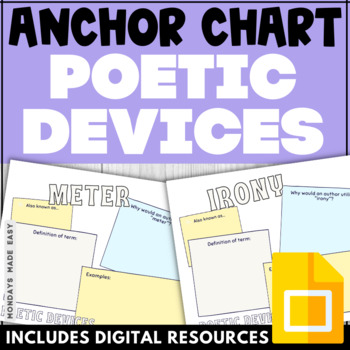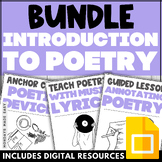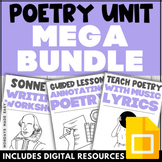Poetic Devices Definitions Anchor Chart - Poetic Device Posters with Examples
- Zip
- Google Apps™

Also included in
- This high school poetry unit includes 190 pages of materials for reading poetry! Explore the elements of poetry, analyzing music lyrics, poetic devices, annotating poetry, and more. Suitable for distance learning and Google Classroom®.⚡️⚡️⚡️ Save 30% with the bundled discount! ⚡️⚡️⚡️Included in this bunPrice $17.50Original Price $26.40Save $8.90
- This modern high school poetry unit will hook even your most reluctant learners! This bundle provides over 300 pages of materials including slideshow lessons, vocabulary activities, poetry writing workshops, assignments, rubrics, and more. Suitable for distance learning and Google Classroom®!⚡️ SavePrice $31.00Original Price $44.30Save $13.30
Description
Teach poetic devices using these vocabulary posters! This anchor chart activity solidifies essential terminology by having students search for poetic device definitions and examples. Includes digital worksheets for Google Classroom®!
Included with this Poetic Devices Vocabulary Activity:
✏️ 31 Poetic Device Posters - Digital & Print
✏️ Poetic Device Definitions and Examples Templates - Collaborative or Individual Activity
✏️ Poetic Device Anchor Chart - Ready-to-Print
✏️ Answer Key for Consolidating this Activity- Ready-to-Print
✏️ Teacher Instructions for using this resource
How to use these Poetic Device Vocabulary Worksheets:
Students will search for poetic device definitions and examples using the poetic device posters provided! Students will feel confident analyzing and interpreting poetic devices in literature and poetry after completing this activity. Once this activity is completed, you can also utilize these vocabulary worksheets as a classroom poetic devices anchor chart.
↠ Begin by deciding if you would like to assign these poetic devices worksheets as a collaborative activity or as an individual workbook.
↠ Each of the poetic device posters prompts students to find a definition and example for the poetic device. It also challenges students to consider why an author would use each poetic device in their writing.
↠ Terms included in these poetic device posters:
- Alliteration
- Allusion
- Amplification
- Aphorism
- Assonance
- Chiasmus
- Cliché
- Consonance
- Couplet
- Dissonance
- Double Entendre
- Enjambment
- Hyperbole
- Imagery
- Irony
- Juxtaposition
- Metaphor
- Mood
- Onomatopoeia
- Personification
- Tone
- and more!
↠ Students can use online resources to find poetic device definitions and to explore why an author would choose to use each device. Then, they can find poetic devices with examples or poetic devices in literature to illustrate the use of each technique. When students apply their own examples from popular culture, these terms become easier to understand!
↠ If you are utilizing these poetic device posters as a collaborative activity, you can have students present their work to the class before hanging their term on the bulletin board. This creates a poetic device anchor chart that can be referenced throughout the course of your poetry unit.
↠ If you are assigning these poetic device worksheets as an individual workbook, you can enable students to create their own personal reference tools. As you explore poetic devices in literature, students can recall poetic device definitions and poetic devices with examples from their worksheets.
↠ As always, a comprehensive answer key has been provided to consolidate this activity. In order to resonate with wider audiences, poetic devices with examples from diverse poets have been included, as well as lyrics from different genres of music.
↠ This answer key doubles as a ready-to-print poetic device anchor chart.
⭒ For classrooms utilizing Google Classroom® ⭒
To access the digital version of these worksheets, simply follow the instructions within the resource to copy the files directly to your Google Drive®.
This resource is included in Mondays Made Easy's Introduction to Poetry Unit.
⭐ Customer Tip! ⭐
Want FREE CREDIT to go towards purchases? Make sure to offer feedback for your downloads! Follow these instructions below:
- Go to your "My Purchases" page to find a "Provide Feedback" button next to each download.
- Follow this link to offer a quick rating and leave a short comment for the product. Each time you give feedback, TPT gives you feedback credits that you use to lower the cost of your future purchases!
- Your feedback is important to me as it helps me to continually improve my products and ensure they are meeting your needs!
Follow me! Be the first to know about product launches, sales, discounts, and free giveaways:
➾ The Blog
For questions, collaborations, or other concerns:
✉ Contact me: hello@mondaysmadeeasy.com
Access my Free Resource Library!
Mondays Made Easy is committed to the continual improvement of resources to meet the current needs of teachers. This product was last updated on March 21, 2022.







